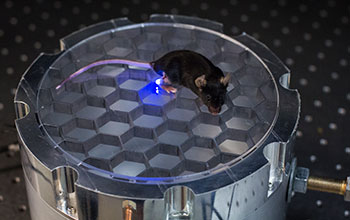Multimedia Gallery
Wireless device stimulates nerves in mice
Engineers at Stanford University's Bio-X lab have developed a blue, glowing device the size of a peppercorn that can activate neurons in the brain, spinal cord or limbs of mice. This mouse's own body transmits energy to the implantable device, which delivers light to stimulate leg nerves.
More about this image
The miniature device combines optogenetics -- using light to control the activity of the brain -- with a newly developed technique to wirelessly power implanted devices and is the first fully internal method of delivering optogenetics.
Traditional optogenetics has required a fiberoptic cable to be attached to a mouse's head to deliver light and control nerves, restricting their movement in enclosed spaces or their ability to burrow into a pile of sleeping cage-mates. The new device dramatically expands the scope of research that can be carried out through optogenetics to include experiments involving mice in enclosed spaces or interacting freely with other animals.
To learn more, see the NSF News From the Field story Stanford engineers develop a wireless, implantable device to stimulate nerves in mice. (Date image taken: August 2014; date originally posted to NSF Multimedia Gallery: Nov. 24, 2015)
Credit: Austin Yee
See other images like this on your iPhone or iPad download NSF Science Zone on the Apple App Store.
Images and other media in the National Science Foundation Multimedia Gallery are available for use in print and electronic material by NSF employees, members of the media, university staff, teachers and the general public. All media in the gallery are intended for personal, educational and nonprofit/non-commercial use only.
Images credited to the National Science Foundation, a federal agency, are in the public domain. The images were created by employees of the United States Government as part of their official duties or prepared by contractors as "works for hire" for NSF. You may freely use NSF-credited images and, at your discretion, credit NSF with a "Courtesy: National Science Foundation" notation.
Additional information about general usage can be found in Conditions.
Also Available:
Download the high-resolution JPG version of the image. (22 KB)
Use your mouse to right-click (Mac users may need to Ctrl-click) the link above and choose the option that will save the file or target to your computer.



